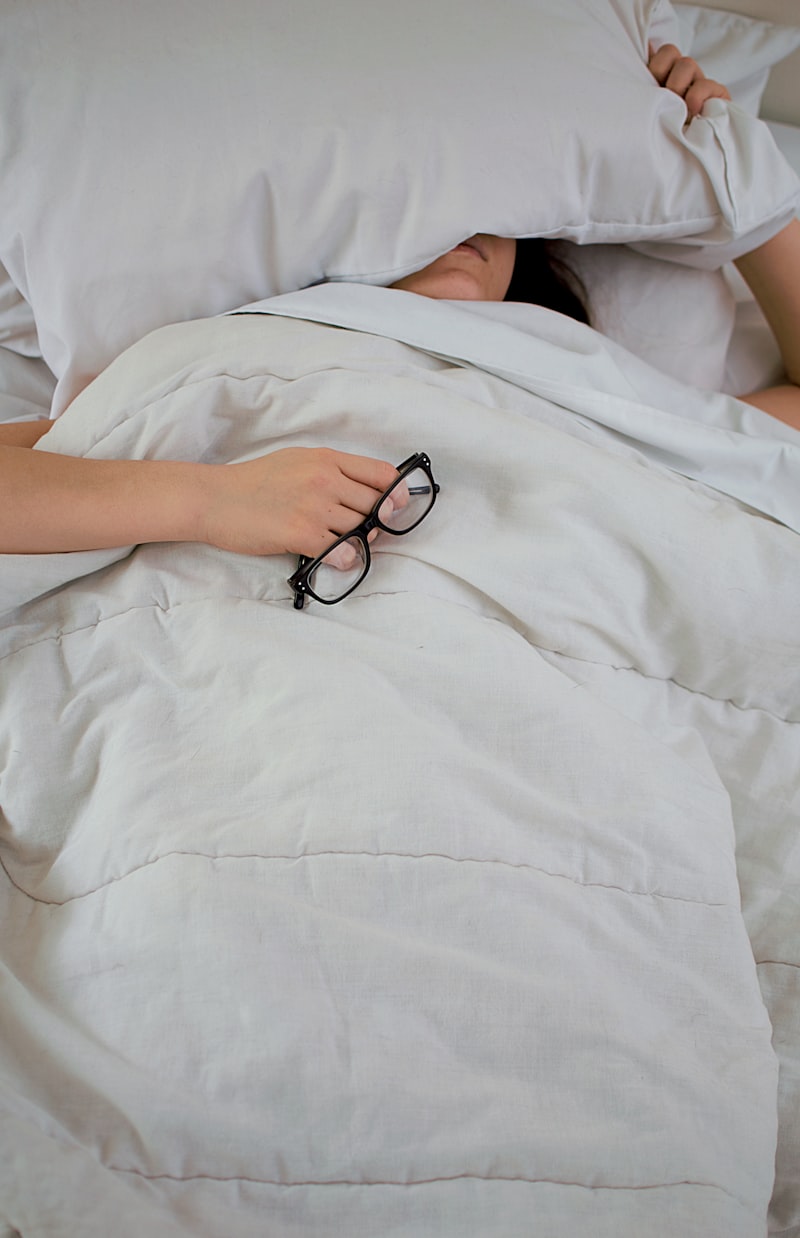When was the last time you had a truly restful night's sleep? If you find yourself tossing and turning, struggling to fall asleep or stay asleep, you might be one of the many individuals affected by sleep disorders. These conditions can have a significant impact on your overall well-being and quality of life. Let's delve into the fascinating world of sleep disorders and uncover the reasons behind those restless nights.
One common sleep disorder is insomnia, which affects millions of people worldwide. Have you ever found yourself lying in bed, wide awake, while the minutes on the clock slowly tick away? Insomnia can make it difficult to fall asleep, maintain sleep throughout the night, or both. Stress, anxiety, medication, and certain medical conditions can contribute to the development of insomnia, leaving you feeling exhausted and irritable during the day.
Another intriguing sleep disorder is sleep apnea. Imagine experiencing multiple interruptions in your breathing while you sleep, leading to brief awakenings throughout the night. This is what individuals with sleep apnea go through. This condition occurs when the airway becomes partially or completely blocked, causing snoring, gasping, or choking sounds. Untreated sleep apnea can lead to excessive daytime sleepiness, decreased cognitive function, and even cardiovascular problems.
Restless Leg Syndrome (RLS) is yet another perplexing sleep disorder. Picture an irresistible urge to move your legs, often accompanied by uncomfortable sensations such as tingling or crawling. RLS typically worsens during periods of rest or inactivity, making it challenging to relax and fall asleep. Although the exact cause of RLS remains unknown, certain factors, such as genetics or underlying medical conditions, may contribute to its development.
Finally, we have narcolepsy, a neurological disorder that disrupts the brain's ability to regulate sleep-wake cycles. People with narcolepsy experience excessive daytime sleepiness, uncontrollable episodes of falling asleep during the day, and sudden muscle weakness triggered by strong emotions. These sudden attacks of sleep can occur at any time, making it dangerous in situations that require attention, such as driving or operating machinery.
Sleep disorders are complex conditions that deserve attention and understanding. Whether it's insomnia, sleep apnea, restless leg syndrome, or narcolepsy, each disorder poses its own challenges to a good night's rest. If you suspect you may have a sleep disorder, it's important to seek medical advice to receive an accurate diagnosis and appropriate treatment options.
Breaking the Cycle: Revolutionary Treatment Offers Hope for Chronic Insomnia
Are you tired of restless nights and endless counting sheep? Do you find yourself trapped in a never-ending cycle of sleepless nights? If so, there's hope on the horizon. Breaking the cycle of chronic insomnia is now possible with a revolutionary treatment that is changing the lives of sleep-deprived individuals.
Insomnia, a common sleep disorder affecting millions worldwide, can have a debilitating impact on one's quality of life. From impaired cognitive function to increased risk of other health conditions, the consequences of chronic insomnia are far-reaching. Fortunately, recent advancements in the field of sleep medicine have led to a breakthrough treatment that offers hope for those grappling with this relentless condition.
This groundbreaking therapy, known as Cognitive Behavioral Therapy for Insomnia (CBT-I), takes a unique approach to treating chronic insomnia. Unlike traditional methods that rely heavily on medication, CBT-I addresses the underlying causes of insomnia by targeting maladaptive thought patterns and behaviors that contribute to sleep disturbances. By reshaping these patterns and promoting healthier sleep habits, CBT-I empowers individuals to regain control of their sleep and break free from the vicious cycle.
Imagine having the ability to establish a consistent sleep routine and conquer the anxiety that accompanies bedtime. CBT-I equips individuals with practical tools and strategies to achieve just that. Through a combination of relaxation techniques, sleep restriction therapy, and cognitive restructuring exercises, patients can gradually rewire their brains to associate bedtime with restfulness instead of restlessness.
Think of CBT-I as a compass guiding you towards a peaceful slumber. It helps individuals identify and challenge negative thoughts that fuel sleep-related anxiety, replacing them with positive affirmations and a sense of calm. This transformative therapy also emphasizes the importance of sleep hygiene, encouraging individuals to create an optimal sleep environment and adopt healthy lifestyle habits conducive to better sleep.
Breaking the cycle of chronic insomnia might seem like an insurmountable task, but CBT-I offers real hope and tangible results. By taking a holistic approach to address the root causes of insomnia, this revolutionary treatment is empowering individuals to reclaim their nights and rejuvenate their lives. So why wait any longer? Take the first step towards a restful future and bid farewell to sleepless nights. Your journey to a good night's sleep begins now.
The Science of Dreams Unraveled: New Study Sheds Light on Sleep Disorders
Have you ever wondered about the mysterious world of dreams? Those vivid, sometimes strange experiences that occur while we sleep have puzzled scientists and philosophers alike. But fear not, for a new groundbreaking study has emerged, shedding light on the science behind dreams and their connection to sleep disorders.
In this study, researchers delved deep into the intricate workings of the human brain during sleep. They discovered that dreams are not mere random images or fantasies but rather the brain's way of processing emotions, memories, and daily experiences. It's like a theater play where your mind takes center stage, replaying and making sense of the events that occurred during wakefulness.
But what happens when this delicate process goes awry? That's where sleep disorders come into play. Conditions such as insomnia, sleep apnea, and narcolepsy can disrupt the natural course of dreams, leaving individuals exhausted and deprived of quality sleep. The study found that these disorders often stem from underlying neurological imbalances or disruptions in the sleep-wake cycle.
Imagine your brain as a symphony orchestra, each section playing its part harmoniously. In healthy sleep, these sections work together seamlessly, allowing you to experience restful slumber and dream-filled nights. However, in the case of sleep disorders, it's as if the conductor loses control, resulting in a disarray of sounds and disrupted melodies.
Fortunately, this new study brings hope. By understanding the intricate mechanisms of sleep disorders, researchers can develop tailored treatments and interventions to restore harmony within the brain. It's like retraining the conductor and bringing back the symphony to its full glory.
So, the next time you find yourself tossing and turning at night or struggling with fatigue during the day, remember that there is a scientific explanation behind your sleeping woes. With ongoing research and advancements, we are inching closer to unraveling the mysteries of dreams and finding effective solutions to sleep disorders. Until then, let's embrace the enigmatic world of dreams and appreciate the wonders of the human mind.
This groundbreaking study offers new insights into the science of dreams and the underlying causes of sleep disorders. By understanding these complexities, scientists are paving the way for innovative treatments that can restore peaceful nights and bring back the symphony of sleep. So, dream on and may your nights be filled with restful slumbers that leave you refreshed and ready to conquer the day!
Sleepless in the City: Urban Lifestyle Takes Toll on Sleep Patterns
Are you tired of tossing and turning in bed while the city keeps you wide awake? If so, you're not alone. The urban lifestyle we lead can take a toll on our sleep patterns, leaving us feeling sleepless in the city. But what exactly is it about city life that disrupts our precious slumber?

One major factor is the constant noise that accompanies city living. The honking of cars, blaring sirens, and bustling crowds can make it difficult to find tranquility at night. Our brains are wired to respond to sounds, particularly loud and sudden ones, which can interrupt our sleep cycles and prevent us from entering deep, restorative sleep.
Another culprit is the bright lights that illuminate the city streets. From flashy billboards to neon signs, our surroundings are filled with artificial light that can confuse our internal body clocks. This disruption to our natural circadian rhythm can lead to difficulties falling asleep and staying asleep throughout the night.
In addition to external factors, the fast-paced nature of urban life itself can contribute to sleeplessness. Busy schedules, long work hours, and a never-ending list of responsibilities can leave us feeling stressed and anxious. This mental and emotional burden can make it challenging to relax and unwind when bedtime rolls around, further exacerbating sleep issues.
So, what can we do to reclaim our sleep in the city? It starts with creating a sleep-friendly environment. Invest in earplugs or sound machines to block out noise, and consider blackout curtains or eye masks to create a dark sleeping space. Establish a soothing bedtime routine that includes activities like reading or taking a warm bath to signal to your body that it's time to wind down.
It's also crucial to prioritize self-care and stress management. Find ways to incorporate relaxation techniques into your daily routine, such as meditation, deep breathing exercises, or gentle yoga. Limit exposure to screens before bed, as the blue light emitted by electronic devices can interfere with melatonin production, a hormone that regulates sleep.
Remember, getting a good night's sleep is essential for our overall health and well-being. By acknowledging the challenges of urban living and taking proactive steps to improve our sleep environment and manage stress, we can reclaim our restful nights and wake up refreshed, ready to conquer the city anew. Sleep tight!
From Nightmares to Serenity: Promising Therapies for Post-Traumatic Sleep Disorders

Do you often find yourself dreading bedtime due to the haunting nightmares that plague your sleep? If so, you might be experiencing a post-traumatic sleep disorder. The impact of traumatic events on our mental health can extend beyond waking hours and infiltrate our dreams, leaving us exhausted and anxious. However, there is hope on the horizon as researchers are diligently exploring promising therapies to alleviate these distressing symptoms.
One innovative therapy gaining traction in the field is called imagery rehearsal therapy (IRT). This approach involves creating a safe space for individuals to revisit their nightmares during wakefulness. By actively altering the outcome of these distressing dreams, patients gradually regain control over their sleep. IRT empowers individuals to rewrite their nightmares into more positive narratives, leading to improved sleep quality and reduced post-traumatic stress symptoms.
Another emerging therapy showing promise is cognitive behavioral therapy for insomnia (CBT-I). While CBT-I has traditionally been used to treat primary insomnia, recent studies have demonstrated its efficacy in managing sleep disturbances related to trauma. By addressing negative thought patterns and maladaptive behaviors that perpetuate sleep difficulties, CBT-I helps individuals develop healthier sleep habits and establish a stronger mind-body connection conducive to restful sleep.
For those seeking non-pharmacological interventions, eye movement desensitization and reprocessing (EMDR) might be a viable option. Originally developed for trauma treatment, EMDR has shown potential in alleviating sleep-related symptoms as well. This therapy combines elements of exposure therapy with rapid eye movements or other forms of bilateral stimulation to facilitate the processing and integration of traumatic memories, ultimately reducing their impact on sleep.
Additionally, certain medications have exhibited effectiveness in managing post-traumatic sleep disorders. Prazosin, an alpha-blocker primarily used for hypertension, has been found to reduce nightmares and improve overall sleep quality in individuals with PTSD. Other medications, such as selective serotonin reuptake inhibitors (SSRIs), may also be prescribed to target both sleep disturbances and the underlying psychiatric symptoms.
The road from traumatic nightmares to restful serenity is no longer an elusive dream. With therapies like imagery rehearsal therapy, cognitive behavioral therapy for insomnia, eye movement desensitization and reprocessing, and medication options, individuals suffering from post-traumatic sleep disorders have a range of promising treatments at their disposal. By seeking professional help and exploring these innovative approaches, you can take significant steps towards reclaiming your nights and waking up to brighter mornings.